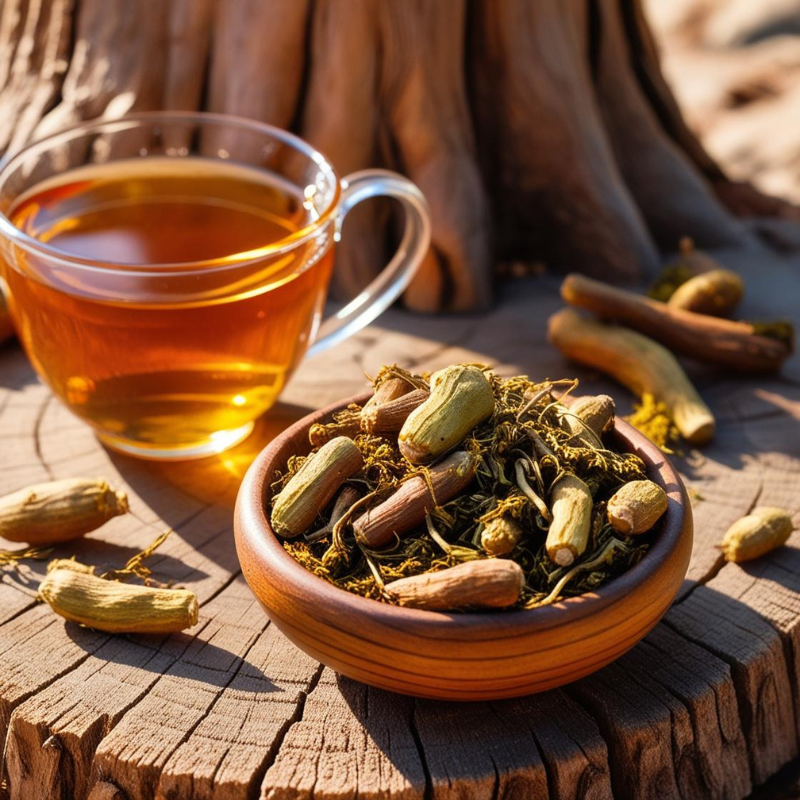Your cart is currently empty!
Exploring the Wonders of Ashwagandha Root: Tradition Meets Modern Science

For generations, people have praised ashwagandha root, formally known as Withania somnifera, as a potent herbal cure. Its continued use in both traditional and contemporary forms of practice highlights its adaptability and potential advantages. This blog post explores the safety concerns, scientific studies, contemporary uses, and historical origins of ashwagandha.
Historical Origins in Ayurvedic Medicine
The ancient Indian medical system known as Ayurveda, which has been used for more than 3,000 years, is where Ashwagandha first appeared. Ashwagandha, sometimes known as “Indian ginseng,” is prized for its ability to reenergize the body and mind. “Ashwagandha” means “smell of the horse,” a reference to the herb’s strong scent and the energy it is said to provide.
Cultural Significance and Traditional Uses
Ashwagandha has long been utilized as a “Rasayana” or rejuvenator to promote energy, longevity, and mental clarity.
Traditionally, ashwagandha was used as a “Rasayana” or rejuvenator to improve mental clarity, vigor, and lifespan. Often recommended to boost energy, strengthen the immune system, and enhance general health, it was essential to ceremonies and healing techniques.
Adaptogenic Properties
In contemporary wellness, Ashwagandha is celebrated as an adaptogen—a natural substance that helps the body adapt to stress and promotes balance. It is used for various internal and external applications:
- Stress Management and Cognitive Health: Ashwagandha is known for its calming effects, often used to manage stress and anxiety. It is also linked to cognitive enhancement, supporting memory and focus.
- Energy and Hormonal Balance: People use Ashwagandha to boost energy levels and stabilize hormones, particularly thyroid and testosterone.
- Skincare and Haircare: Externally, it is used in creams and oils to soothe the skin and promote healthy hair.
Forms of Ashwagandha
There are various types of ashwagandha, and each is appropriate for a certain need:
Powder: Used for internal health advantages, frequently combined with milk or water.
Tinctures and capsules: These convenient daily supplementing methods provide accurate dosage.
Teas: A calming approach to take advantage of their health benefits, especially for reducing stress.

Topically: applied oils and creams are used for hair and skin care.
Scientific Research Evidence-Based Benefits
The possible health advantages of ashwagandha have been investigated in recent scientific investigations. Here are some important conclusions:
- Stress and Anxiety Relief: According to a study that was published in PubMed Central, ashwagandha can help individuals feel less stressed and anxious
- Cognitive Enhancement: According to research published in the National Library of Medicine, ashwagandha may help with memory and cognitive function.
- Physical Endurance and Muscle Recovery: Studies have demonstrated that ashwagandha improves both physical endurance and muscular recovery, which has been found to improve physical performance (PubMed).
- Hormonal Balance: Studies show that it helps maintain testosterone levels and thyroid function (National Library of Medicine).
- Anti-inflammatory and Antioxidant Properties: Its natural components have antioxidant and anti-inflammatory properties that are good for general health (PubMed).
Contraindications and Safety Information
Who Should Avoid Ashwagandha?
Although ashwagandha is generally regarded as safe for the majority of people, several groups should be cautious:
- Pregnant or Breastfeeding Women: A healthcare professional must be consulted regarding potential dangers during pregnancy and lactation.
- Individuals with Autoimmune Disorders: People with autoimmune diseases may experience issues as a result of ashwagandha’s potential to boost the immune system.
- Medication Interactions: Before using any drugs, especially those for anxiety or thyroid conditions, people should consult a doctor.
Side Effects and Overdose Risks
Although they are uncommon, allergic reactions or gastrointestinal distress are possible adverse effects for certain people. To prevent possible interactions and overdose hazards, it is imperative to follow prescribed dosage guidelines and seek medical advice.
Conclusion
A mainstay of Ayurvedic medicine, ashwagandha root never fails to enchant with its many uses and scientifically proven advantages. It has a wide range of applications, including stress reduction, cognitive improvement, and hormonal balancing. But it is crucial to do a responsible investigation into its advantages while following medical professionals’ advice.
Disclaimer: This information is for educational purposes only and should not substitute professional medical advice. Always consult a healthcare provider before starting new supplements.

